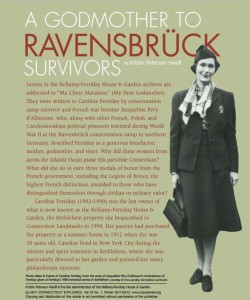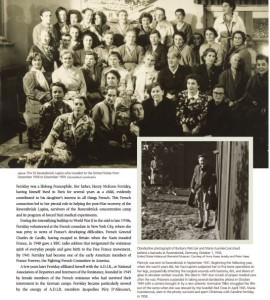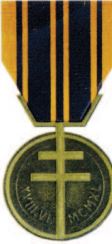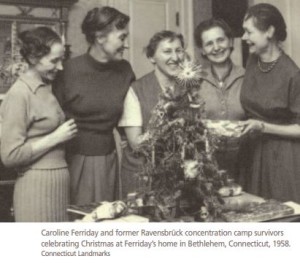By Kristin Peterson Havill WINTER 2011/12
 Letters in the Bellamy-Ferriday House & Garden archives are addressed to “Ma Chere Marainne” (My Dear Godmother). They were written to Caroline Ferriday by concentration camp survivor and French war heroine Jacqueline Péry d’Alincourt, who, along with other French, Polish, and Czechoslovakian political prisoners interned during World War II at the Ravensbrück concentration camp in northern Germany, described Ferriday as a generous benefactor, mother, godmother, and sister. Why did these women from across the Atlantic Ocean praise this part-time Connectican? What did she do to earn three medals of honor from the French government, including the Legion of Honor, the highest French distinction, awarded to those who have distinguished themselves through civilian or military valor? Caroline Ferriday (1902-1990) was the last owner of what is now known as the Bellamy-Ferriday House & Garden, the Bethlehem property she bequeathed to Connecticut Landmarks in 1990. Her parents had purchased the property as a summer home in 1912 when she was 10 years old. Caroline lived in New York City during the winters and spent summers in Bethlehem, where she was particularly devoted to her garden and pursued her many philanthropic interests.
Letters in the Bellamy-Ferriday House & Garden archives are addressed to “Ma Chere Marainne” (My Dear Godmother). They were written to Caroline Ferriday by concentration camp survivor and French war heroine Jacqueline Péry d’Alincourt, who, along with other French, Polish, and Czechoslovakian political prisoners interned during World War II at the Ravensbrück concentration camp in northern Germany, described Ferriday as a generous benefactor, mother, godmother, and sister. Why did these women from across the Atlantic Ocean praise this part-time Connectican? What did she do to earn three medals of honor from the French government, including the Legion of Honor, the highest French distinction, awarded to those who have distinguished themselves through civilian or military valor? Caroline Ferriday (1902-1990) was the last owner of what is now known as the Bellamy-Ferriday House & Garden, the Bethlehem property she bequeathed to Connecticut Landmarks in 1990. Her parents had purchased the property as a summer home in 1912 when she was 10 years old. Caroline lived in New York City during the winters and spent summers in Bethlehem, where she was particularly devoted to her garden and pursued her many philanthropic interests.
Ferriday was a lifelong Francophile. Her father, Henry McKeen Ferriday, having himself lived in Paris for several years as a child, evidently contributed to his daughter’s interest in all things French. This French connection led to her pivotal role in helping the post-War recovery of the Ravensbrück Lapins, survivors of the Ravensbrück concentration camp and its program of forced Nazi medical experiments.
During the intensifying buildup to World WarII in the mid to late 1930s, Ferriday volunteered at the French consulate in New York City, where she was privy to news of France’s developing difficulties. French General Charles de Gaulle, having escaped to Britain when the Nazis invaded France, in 1940 gave a BBC radio address that invigorated the resistance spirit of everyday people and gave birth to the Free France movement. By 1941 Ferriday had become one of the early American members of France Forever, the Fighting French Committee in America.
A few yearslater Ferriday affiliated herself with the A.D.I.R., or National Association of Deportees and Internees of the Resistance, founded in 1945 by female members of the French resistance who had survived their internment in the German camps. Ferriday became particularly moved by the energy of A.D.I.R. members Jacqueline Péry D’Alincourt, Genevieve de Gaulle, Anise Postel-Vinay, and Germaine Tillon, four women who had bonded as political prisoners in Ravensbrück.
Genevieve de Gaulle, the 19-year-old niece of General de Gaulle, immediately joined the war effort after her uncle’s BBC address to the French people. In July 1943 she was arrested by the Gestapo and six months later was sent to Ravensbrück, where she remained as a special political prisoner for the remainder of the war.
Jacqueline Péry D’Alincourt, from a family of Breton aristocracy, was a young war widow in 1942. She joined the resistance that year after seeing a young Jewish child in a Paris train station with a yellow star pinned to her dress. One of her roles in the resistance involved finding accommodations for underground agents by renting hard-to-find housing in her own name. This activity led the Nazis to her when one of the agents she had helped was caught. She was sent to Ravensbrück in 1943 at age 24.
Anise Postel-Vinay, the daughter of a woman who took in refugees and whose knowledge of the German language proved to be an asset, was arrested for acts of resistance in August 1942 at age 20. Germaine Tillon, a graduate of the Sorbonne and a French anthropologist, was arrested for helping prisoners escape and for organizing intelligence forthe allied forces. Betrayed by a priest, Tillon was captured at age 36 and deported to Ravensbrück, along with Postel-Vinay, in October 1943. They were designated as NN (Nacht und Nebel, or “night and fog”), political prisoners who were meant to disappear and never be heard from again.
These four women, however, did not disappear. All were later to have an impact on Ferriday’s life.
Ravensbrück, located 50 miles north of Berlin, was a forced labor camp for women. Prisoners from more than 30 countries were forced to work under brutal conditions in agriculture, local industry, the production of armaments, and camp maintenance.
Our knowledge of Ravensbrück comes primarily from survivors. Tillon, for example, wrote an eyewitness account in a book published in 1973. Tillon described the remarkable camaraderie that formed among many of the prisoners.
Beginning in August 1942, the Nazis began a program of medical experiments on young Polish high school and university students imprisoned in Ravensbrück. The Polish population there was the largest of those from any country, and the Nazis considered Poles racially inferior. The experiments focused on young women in part because females tended to be the healthiest prisoners. The inmates used the name “Lapins” (rabbits) to describe the women being used for these lab experiments. The young women were subjected to up to six operations each, including having the bones and muscles in their legs broken, cut out, or otherwise damaged. Their wounds were then deliberately infected with bacteria. A total of 74 Lapins were subjected to these horrific experiments; 63 survived the war, largely due to the help of other inmates.
Word reached the outside world via notes passed at great risk by prisoners working in factories and hidden in correspondence with families. The plight of the Ravensbrück Lapins became a cause célèbre for a unified network of underground resistance. In the 1950s, Ferriday joined the effort to help the Lapins, whom she had learned about through her affiliation with the A.D.I.R.
In 1958, 13 years after the end of World War II, Ferriday was among the first to awaken the American public to the horrors of Ravensbrück. The camp had been liberated by the Russian Army, not the American, and was behind the Iron Curtain. For this reason, and because it was a camp for women and not specifically devoted to the extermination of the Jews, the history of this camp was slow to emerge.
Benjamin Fermenz, a war crimes prosecutor, recalls his first meeting with Ferriday. “One day, in 1957, a very nice young lady, named Caroline Ferriday showed up at my office with an interesting plea. From her association with various anti-Nazi organizations, she had learned about young Polish women who had been shipped to the concentration camp at Ravensbrück where they were subjected to a host of medical experiments . . . Miss Ferriday knew that I had helped Jewish claimants, and she wondered if I would also come to the aid of the Catholic ladies from Poland.” Fermenz noted that Ferriday had already approached Norman Cousins, editor of the magazine Saturday Review, for help; Cousins had, she knew, arranged to bring a group of “Hiroshima Maidens” to the U.S. for cosmetic surgery. Would he consider doing the same for the scarred young women of Ravensbrück?
Ferriday traveled to Warsaw in 1958 and acted as an emissary and liaison to meet with Polish officials and to gain the trust of the Lapins. She and Cousins, who had indeed agreed to help, contacted the Lapins, now in Poland, and arranged their trip to the United States for care.

The French Médaille de la Résistance (Medal of the Resistance) was awarded to
Caroline Ferriday by the French Government. Connecticut Landmarks
Cousins wrote a series of three articles about the Lapins that appeared in the Saturday Review in 1958 and 1959. The stories captured the hearts of Americans and gave Ferriday credit for her motivating role. “Caroline Ferriday has an almost magical gift for inspiring confidence. Her first few days in Warsaw were not without their difficulties, but after awhile the project began to move. Then, at the end of the week, we received a cable saying that the Polish authorities were cooperative and gracious and that prospects were excellent.”
“Our Dear Miss Caroline,” an unidentified woman among the group wrote, “you have won our hearts immediately through your kindness . . . We are moved by your dedication in our behalf.”
Ferriday returned to Warsaw a second time that year with Dr. William Hitzig, a prominent New York physician who also had aided Japanese victims of the atomic bomb for the Hiroshima Maidens project. Representing American doctors who had agreed to treat the Lapins if they came to the United States, Dr. Hitzig examined the women and assessed their medical needs.
Of the 53 Lapins still surviving in 1958, 35 made the trip to the United States for a stay that lasted from December 1958 to December 1959. The Lapins, renamed the Ladies, stayed in small groups with host families in 12 cities from Boston to San Francisco. In addition to the medical treatment they received, Cousins wrote, “the most remarkable change in the group as a whole… was in the emotional and psychological regeneration of the Ladies.”
Four of the women spent Christmas in Bethlehem, Connecticut with Ferriday. This visit was described in a December 26 newspaper article: Four women, who have seen more hell in their lifetime than a human mind can imagine are here today spending a quiet happy Christmas holiday in this village named after the town where Christ was born . . . On the table in the living room of Miss Ferriday’s large colonial home is a small Christmas tree that they brought from Poland. It is decorated in the traditional manner, with candies and paper ornaments and with an angel on top. The small tree symbolizes the hope that has kept all the Ravensbrück Lapins alive since they returned to Poland…
In spring 1959 the Ladies gathered in San Francisco and began a cross-country tour. On their way to their final engagement in New York they stopped in Washington, D.C., where Cousins reported “a large number of Senators and Representatives was host to the Ladies at a special lunch in the Senate dining room” and they “gasped with delight when Senator Frank Carlson of Kansas called the attention of the Senate to their presence.”
As reported in the Congressional Record on May 19, 1959, Senator Edmund Muskie, whose father had emigrated from Poland, spoke before the Senate after the Ladies returned to Poland, “paying particular tribute to Mr. Norman Cousins and to Miss Caroline Ferriday for the dedication and the interest they have given to this project, without which it would not have materialized . . . It is significant, I think, that even now a decade and a half after the end of the war, we are still far from having achieved substantial justice for these victims of some of the most inhuman actions on record.”
Two days after the Ladies were introduced to the Senate, with attention garnered from the U.S. tour, the Ravensbrück Lapins Committee, which was legally empowered to act for the women, received a check from the German embassy to pay the medical costsfor 30 of the women during their stay in America and was told “that the Federal Government was thoroughly and urgently examining possibilities of further relief.”
Ferriday continued to maintain relationships with several of the Ladies and other Ravensbrück internees, including Milena Seborova, the daughter of a justice of the Czechoslovakian supreme court, who was deported to Ravensbrück in 1941 when she was 25 years old. She was later decorated by her country with the Military Cross for bravery and by France and Norway for saving the lives of her fellow French and Norwegian prisoners. She suffered further when she was imprisoned after the war after rejoining the underground in the fight against Russian communists. Five more years of imprisonment and hard labor for this young woman took its toll. Because of her heroic acts while at Ravensbrück, the French A.D.I.R. survivors put her in touch with Ferriday. Ferriday wrote, “I feel like your mother in many respects. . . .”
Caroline Ferriday died on April 27, 1990. Jacqueline Péry D’Alincourt attended her memorial service at Bethlehem’s Christ Church on April 28, 1990. In a 1991 copy of a small self-bound tribute she wrote: “In our first meeting our friendship was sealed. She wanted to know everything. She asked ‘What can I do?’ Every year she welcomed me to the lovely Connecticut home where she lived since 1913. Such was the incomparable benefactor of our association.”
Genevieve de Gaulle, too, wrote a memorial tribute, hers appearing in the March/April 1991 A.D.I.R. newsletter Voix et Visages. She described Ferriday as “a sister to everyone. She helped us to gain recognition first, and then to compensate the victims of pseudo-medical experiments. She brought about this action with all herintelligence, all her generosity…”
Visitors to the Bellamy-Ferriday House will see an autographed photograph of General de Gaulle and a certificate commending her for her service to the French cause. The typewriter next to her desk is a reminder of her lifelong correspondence with her international friends and herlettersto various newspapers and officials that helped keep alive an interest in the plight of the Ravensbrück Ladies.
